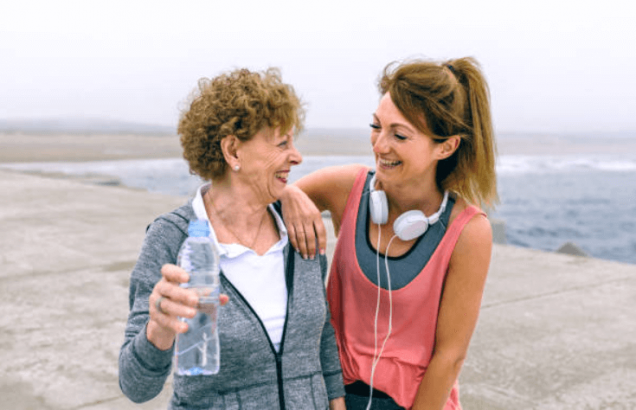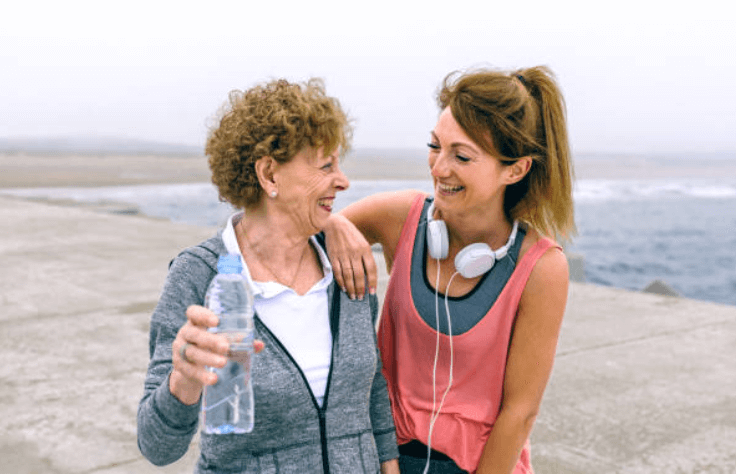Exercise has so many benefits for all ages and in the case of people as they age, they could include greater flexibility, prevention of falls, better bone density, keeping illness at bay through stronger immunity, reducing the risk of dementia and gaining more confidence, not to mention independence.
There are many ways to engage with exercise, depending on your personal health and fitness goals.
Stick to an exercise routine
Exercise works best when we do it on a regular basis. For seniors, twenty to thirty minutes a day of moving your body other than the incidental exercise you get is recommended. To help you create and stick to a routine, put it on a calendar so you remember every day. Set an alarm on your phone for the same time each day and be ready with a plan for what you’ll do: walking, stretching, dancing, lift gentle weights or whatever else you choose.
Keeping a weekly or twice-weekly booking with your support worker is a good way to make sure you get your exercise in, at least on those days. Search for someone who can provide extra motivation and encouragement to keep you on track with your goals.
Stretching and tightening
Our muscles need to be moved so we can retain our flexibility and stability. Yoga and Pilates are fantastic modes of exercise that are suitable for absolutely any age and fitness level. Don’t think you could do them? You’d be amazed! Yoga will restore your stability and flexibility, relieve stress, help you relax and sleep better and give you helpful breathing techniques. It’s a stretching and breathing technique that you can do even if you’ve never done it before, are overweight, unfit or uncoordinated. It can be done at home in your living room, out on the back lawn, in a rooftop barbecue area or in a professional studio.
For Pilates, you’ll probably need to go to a studio where you’ll use the equipment and be supervised through all your exercises.
Build strength
Regular strength training can go a long way to reducing symptoms of diabetes, arthritis and other conditions. It could also protect against osteoporosis. It doesn’t mean you have to go to the gym and lift heavy barbells; you can put a can of pineapple in each hand and do some bicep curls or have your cat in your lap while you do calf raises. You could find an exercise physiologist, a personal trainer or a physiotherapist on Mable who can create a very do-able program for you to do at home. They’ll work with you to do your strength exercises using whatever you have at home.
Cardio workouts
Anything that gets your heart beating faster could be a useful cardio workout. A good, brisk walk around the block is beneficial or even dancing in your lounge room to your favourite music would work. Gardening is another smart idea to raise your pulse. Look for an independent support worker on Mable who, after meeting you and determining your abilities can come up with some cardio exercises for you. This would be a personal trainer, physio or exercise physiologist.
Fun and laughter through exercise
Nobody said you can’t have fun when exercising. In fact, it should be a requirement! Having fun brings out the child in us all and reminds us that we’re capable of enjoying every single day. Fun equals relaxation so even though you might think you’re working out, you’re actually doing your body a big favour. Silly activities can make you laugh while doing them, and that’s even better. Laughter works your abdominal muscles, reduces your levels of stress hormones, triggers the release of endorphins (the feel-good hormones), lowers your blood pressure and gives you a lovely sense of wellbeing.
Why not post an ad for an independent support worker who can bring the laughs and help you with your exercise Here’s an example of some wording that you can copy/paste into your job ad and just change the details as necessary:
“Hello, my name is Anne. I’m looking for a support worker who can make exercise FUN for me! I’m told laughter is important too so I’d like to meet someone who is funny and light-hearted but can guide me through some exercises that suit my ability.”
Don’t forget incidental exercise
Always be mindful that movement is good. We’ve become spoilt over the last decades through things like TV remote controls, automatic washing machines and digital home assistants like Amazon’s Alexa and Google Home. You can still keep yourself moving though by:
- Getting up and going to the fridge for a glass of water instead of keeping a big bottle by your couch
- Standing up while reading the mail or folding the washing
- Walking around the house when you’re on the phone
- Washing up instead of using the dishwasher
- Standing up and playing with the dog during commercial breaks
- Eating meals at the table instead of in front of the TV
- Sweeping the floor, even if just part of the kitchen at first.
Whatever you do, “keep it moving”!

